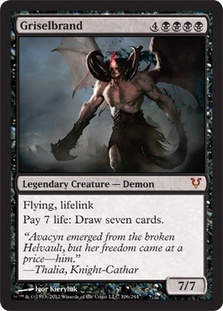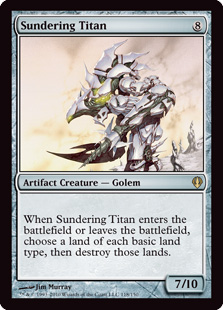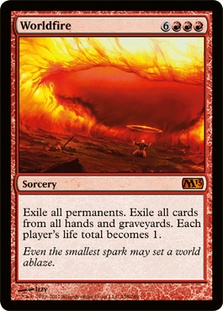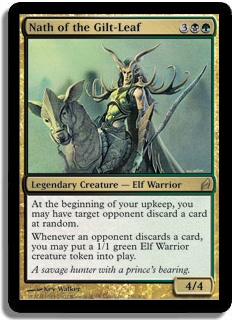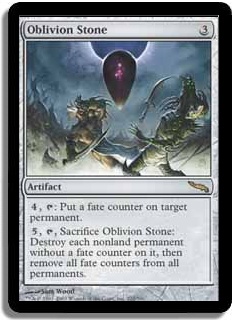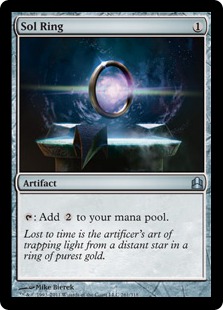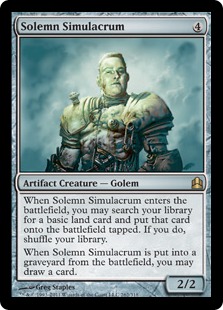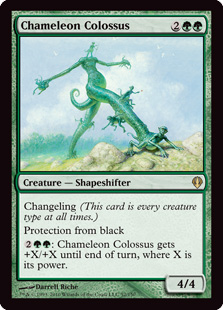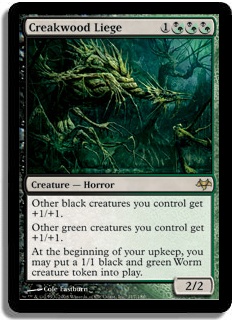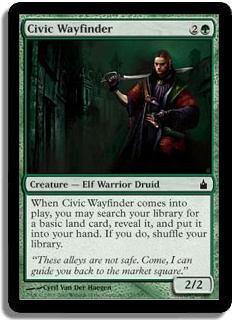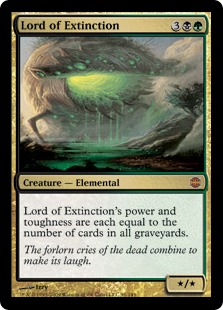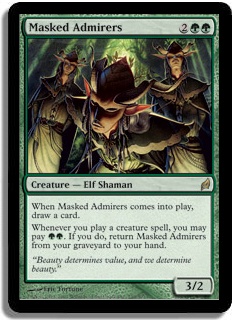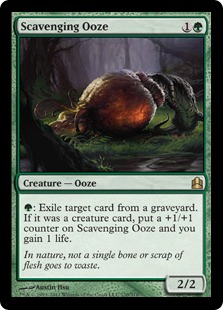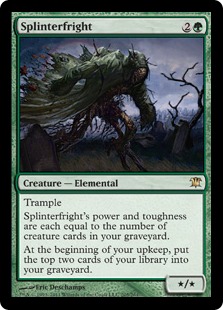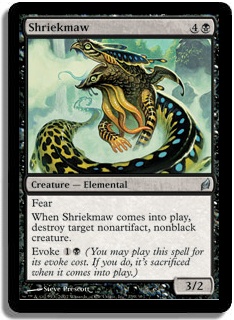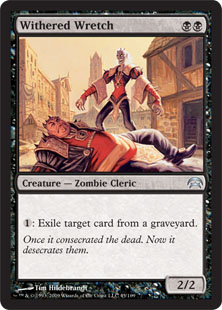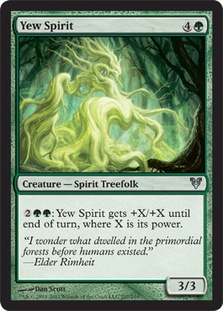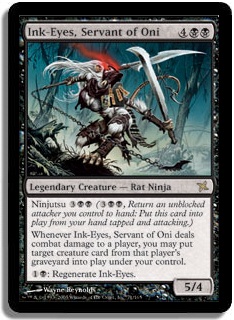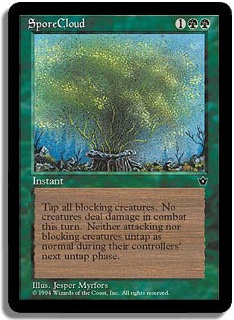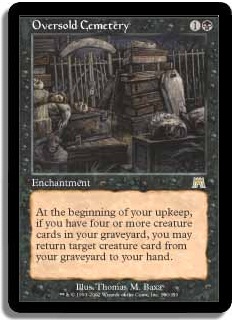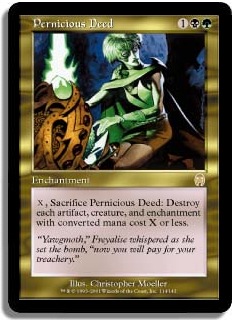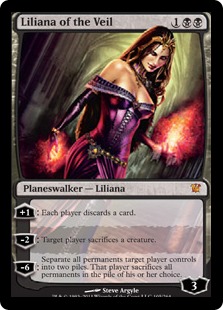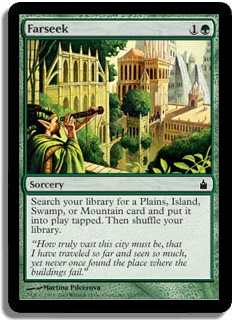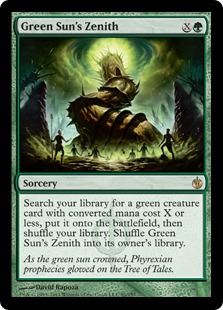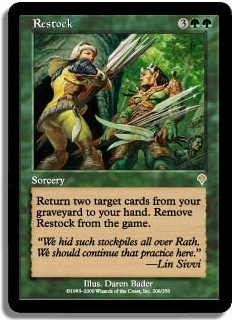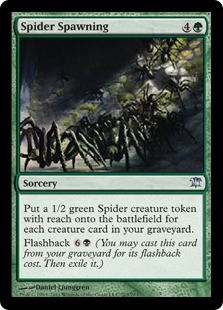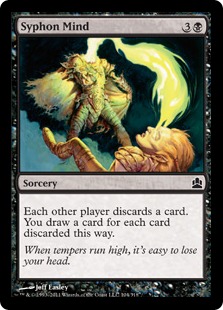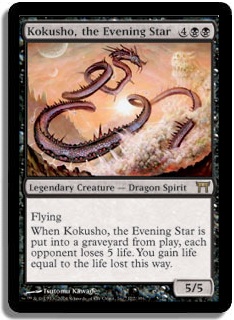But First, The News You’ve Been Waiting For: June 20, 2012 Banned List Update
Griselbrand is BANNED.
Sundering Titan is BANNED.
No other changes.
Griselbrand was relatively simple choice. We knew all along it was pretty busted. While we had a glimmer of hope that the batch-of-seven card draw would help mitigate the obvious problem of a player being able to draw so many cards immediately (like Yawgmoth’s Bargain, unlike Necropotence), it simply didn’t. Griselbrand’s lifelink ability allowing you more resources to draw cards with coupled with being a creature and therefore easier to get into play (not to mention repeatedly) for far less than his mana cost, led to quite degenerate game states.
Sundering Titan has long been a card on the edge. The decision to get rid of it came from the combination of two points. One, it simply created undesirable game states. It was too easily both intentionally abused and unintentionally game warping, especially since its ability triggers on both entering and leaving the battlefield. Two, there has been a fair amount of community distaste for the card, and we agreed that the card overwhelmingly creates a negative experience for players. Listening to the ever-growing and ever more-involved community is important to us.
There’s an M13 card—Worldfire—that’s been generating some talk. We’re going to keep a close eye on the card after its release to look at its impact and potential impact on the format, but there’s no reason to panic and pre-ban it. Banning cards is about what they do, not about what they might do, so like we did with Griselbrand and despite what we see as a likely outcome, we’d like to see some evidence of it first.
As a side note, remember that there is ongoing Kokusho testing (see the notes below the decklist), so no decision will be made on it until the September update at the earliest.
Nath of the Gilt-Leaf
I’ve wanted to build a Nath deck for quite a while now, and I finally got around to it. This deck is heavily suggested by a deck built at least two years ago by then fellow Team Lives in the Red Zone member Brennan DeCandio. What I liked about it at the time was that it was just tight. It was active, direct, and it seemed like he was doing something every turn.
Fast-forward those two years. I decided that I was going to take his idea and distill it a bit. The first basic premise is that the converted mana cost of every card is five or less. That gets bent a bit with two X spells, but that’s hardly a sin. The second basic premise is dollar value. With a very few exceptions, the cards are all inexpensive. Here’s a list of the cards that are over $15:
Dark Confidant: $50
Scavenging Ooze: $40
Damnation: $30
Sword of Light and Shadow: $30
Sword of Feast and Famine: $25
Liliana of the Veil: $22
Overgrown Tomb: $20
Volrath’s Stronghold: $20
Demonic Tutor:Â $18
Pernicious Deed: $18
The Swords are moderately easily replaced with other equipment that does stuff you like. Liliana can be sacrificed for a discard spell. Overgrown Tomb can go for a basic land since you’re in two colors. Dark Confidant can become Dark Tutelage (49 cents) or Phyrexian Arena ($4). Demonic Tutor is simply replaced with Diabolic Tutor (also 49 cents). Scavenging Ooze is a little tricky to replace because Withered Wretch is already in the deck, so you might have to go with something like Scrabbling Claws (25 cents), which would work better because there is Glissa the Traitor in the deck.
Damnation and Pernicious Deed are a little tough to replace, as is Stronghold, but it’s not like they’re huge linchpins of the deck anyway. Nevinyrral’s Disk ($6) could easily replace the Deed. You could take a bit of a liberty with the CMC of five by replacing Damnation with Black Sun’s Zenith ($3) or Forced March ($1), or get tricky and use Whirlwind ($1).
The deck just does stuff. It gets out cost-effective guys early and puts on pressure. It draws a few cards and doesn’t over-focus on the general’s ability. It’s not particularly tricky to play, but seems like moderate amounts of good times. Note that upcoming M13 cards weren’t considered, so there might up a few updates after the first few weeks. Let’s get to it:
COMMANDER (1)
Nath of the Gilt-Leaf:Â The ability doesn’t cost you anything, which is always a bonus. His power is enough that you can consider attacking with him, and in a long game, killing with General damage.
ARTIFACTS (6)
Eldrazi Monument:Â The large number of creatures and side theme of graveyard recursion makes this an excellent inclusion. You don’t actually need Avenger of Zendikar armies to do extremely well with this in play.
Nihil Spellbomb:Â Cheap and effective; it’s Relic of Progenitus for that one player who is getting out of hand with the graveyard.
Oblivion Stone:Â There are times when other folks get out of hand. Let’s get them back in.
Sol Ring:Â You have to get started somewhere, somehow.
Sword of Light and Shadow:Â The life gain is nice, but getting back one of your easily cast creatures is the important part.
Sword of Feast and Famine:Â Unlike a lot of mana-hungry decks the second ability isn’t quite as significant here, but especially on early turns can give you a fair amount of ramp.
ARTIFACT CREATURES (1)
Solemn Simulacrum:Â Despite my love for Julia Louis-Dreyfus, VEEP has been uneven so far with a few bright spots. I am, however, developing quite a thing for Anna Chlumsky.
CREATURES (28)
Acidic Slime:Â One of the best utility creatures ever; the deathtouch ability pairs well with both blocking and the Ulvenwald Tracker below.
Blood Artist:Â One of my favorites from Avacyn Restored, Reverse Suture Ghoul is going to drain people. Particularly nice when you Maelstrom Pulse someone’s Plant tokens away.
Bloodline Keeper:Â Even in a non-Vampire deck, the card has a simple efficiency. If left alive too long, he can get out of hand.
Chameleon Colossus:Â Combining Protection from black and his pumping ability get can him through for piles of damage, especially when you have it available because your other stuff is cheap to cast. This guy is a Vampire too.
Civic Wayfinder:Â Some simple ramp.
Creakwood Liege:Â Your guys are bigger and you get more guys. If card quality were the only deciding factor, I’d still have this guy in my Kresh deck. The only reason I took him out is that I wanted to play other stuff.
Dark Confidant:Â No EDH deck wants Bob more than this one since the most you can lose is five.
Deranged Hermit: Remember that the Squirrel tokens stay even when he leaves play. In a phrase I’ll probably repeat throughout this list, the deck’s mana efficiency probably lets you pay the echo for this frequently—although you might not want to since you have some graveyard recursion and you want more Squirrels.
Eternal Witness:Â The major question for me about “Prometheus” is “replicant or not?”
Fauna Shaman:Â Survival of the Fittest ended up on the cutting room floor of this deck due to price. Fauna Shaman is a fine replacement.
Genesis:Â We see less of Genesis than we did in the earliest days of the format when it was unparalleled in the graveyard recursion category.
Indrik Stomphowler:Â Naturalize on a good-sized body.
Lord of Extinction:Â Late game, one of the most mana-efficient guys ever. You’d actually be surprised how good he can be earlier. Sure, he’s not 50/50 or anything, but even 10/10 for five mana is good.
Lotus Cobra:Â This is a leftover from Brennan’s original deck, and although I’m not really sure how good it is without lots of fetchlands, it mitigates some of the disadvantages of the weaker but less pricey fetches. We’ll see how it runs.
Masked Admirers:Â Draws cards and regrows itself. Value. Also putting this in my Animar deck when the foils come in.
Master of the Wild Hunt:Â Even if you don’t often use the second ability, the first is a passive way of getting guys into play. Too bad Feed the Pack costs six.
Necrotic Ooze:Â The Ooze is a card that creates unintentional epic plays, which I’m all for.
Oracle of Mul Daya:Â A rarely discussed side benefit of land ramp is that you’re not drawing dead cards later in the game.
Sakura-Tribe Elder:Â See Oracle of Mul Daya.
Scavenging Ooze:Â Other people will recur stuff from their yard, especially good creatures. You shouldn’t let them.
Shriekmaw:Â The evoke ability feeds both recursion and Oversold Cemetery. This could also be Bone Shredder.
Splinterfright:Â Splat/Splat guys can get out of hand when their conditions are met. Does the guy die to Relic of Progenitus? Yep. Every deck has a vulnerability.
Stingerfling Spider:Â After he’s done his duty upon entering the battlefield, he can also fight small dudes courtesy of …
Ulvenwald Tracker:Â This guy. Fight is an interesting mechanic that I hope R&D explores a little more. Wonder if they’ll ever do a “beats up” mechanic where one creature deals damage to the other but the other one never has a chance to deal it back.
Viridian Shaman:Â Artifacts are good. The best of them must be destroyed.
Withered Wretch:Â If I had a dollar for every time I said, “People don’t run enough graveyard hate,” I could retire.
Wood Elves:Â Had some discussions and even a poll on playing this versus Yavimaya Dryad, and this won going away. Like Reagan versus Mondale numbers.
Yew Spirit:Â Not quite as good as the Colossus without protection, but worth running as well.
LEGENDARY CREATURES (3)
Glissa, the Traitor: There are only a few things in the Glissa package in the deck. It’s in there for recursion of the Spellbomb and Oblivion Stone, although it can be nice to get back your Swords if they get blown up. Most folks forget that she has deathtouch and first strike, making her a significant defensive creature—or putting people in a no-win combat situation when she’s equipped with a Sword.
Ink-Eyes, Servant of Oni:Â Small creatures tend to get shrugged about when they attack. You can probably only pull this trick so many times before people are going to start killing them. This creature by itself might be a reason to run the Forestwalking Dryad over Wood Elves.
Thrun, the Last Troll:Â A solid creature at a solid cost.
INSTANTS (3)
Makeshift Mannequin:Â Getting anything back from the graveyard into play as an instant is serious value.
Putrefy:Â Stuff’s gotta go. Most folks forget the “can’t be regenerated” part. The Player Rewards version is pimp.
Spore Cloud:Â I have an irrational fondness for this card. Not only does it fog, but they don’t get to untap next turn either. Hilarious if you’re just an observer in a giant combat where there are large numbers of creatures both attacking and blocking.
ENCHANTMENT (5)
Animate Dead:Â Oh, wall of text, how we adore thee. Just in case, here’s the part between “Enchant creature card in a graveyard “and” enchanted creature gets -1/-0.” “When Animate Dead enters the battlefield, if it’s on the battlefield, it loses “enchant creature card in a graveyard” and gains “enchant creature put onto the battlefield with Animate Dead.” Return enchanted creature card to the battlefield under your control and attach Animate Dead to it. When Animate Dead leaves the battlefield, that creature’s controller sacrifices it.”
Diabolic Servitude:Â I think there’s a way to engage in quite some jackanapery with this card. I just haven’t figured it all out yet.
Greater Good:Â Not quite as good as it might be with lots of fatter creatures, but it can help fill the yard with juicy Reanimation targets or setting up for that big Living Death.
Oversold Cemetery: Â Another passive upkeep ability; getting guys from graveyard to hand without having to pay for it is the equivalent of free card draw.
Pernicious Deed:Â The CMC of this card might be only three, but it often gets blown up for well more than that. Note that it doesn’t take out planeswalkers.
PLANESWALKERS (3)
Garruk Relentless:Â I love this card because you have to play it. You can’t just drop it down and let it do what it does; you have to figure out how best to use it all the time. Great design.
Garruk, Primal Hunter:Â It’s either immediate card draw or immediate dudes. It’s the kind of planeswalker that opponents don’t immediately lose their minds about (ref: Elspeth), but know not to let stay around if they can help it.
Liliana of the Veil:Â The flexibility of the card is amazing. Obviously the discard works with Nath, but it doesn’t need to in order to have value.
SORCERIES (13)
Beacon of Unrest:Â Folks forget that this can get artifacts as well and can get stuff from anyone’s graveyard.
Damnation:Â Sometimes everyone needs to die. That’s all there is. It won’t hurt if your own Blood Artist is one of the things that goes.
Demonic Tutor:Â I can’t imagine too often getting anything that’s not Damnation or Living Death.
Dread Return:Â Effectively the same cost as Zombify, only with a nice additional option. Sacrificing three creatures just fuels some of the other good stuff in the deck.
Farseek:Â The reason this is better than Rampant Growth is that you can get a dual land with it. You’re either getting Overgrown Tomb or a Swamp in this particular deck, but in decks that are less budget-conscious this often-overlooked card is awesome.
Green Sun’s Zenith:Â You’ll never spend too much mana on this. Early turns it’s a ramp creature, later it’s utility. Sure, it’s a little cheaty with the “nothing greater than five idea” considering that you could actually spend six on it, but I think that’s fine.
Living Death:Â Certainly can be used as an emergency Wrath; remember that this card circumvents Grafdigger’s Cage because the creatures come onto the battlefield from exile.
Maelstrom Pulse:Â Being a cheap token-killer is most of what you need to know about the card in this format. Being an emergency get-rid-of-anything spell is just gravy.
Profane Command:Â Ok, most of the time you cast this it’ll cost more than five. I think it’s okay to have one little thing that breaks the mold. Then again, maybe there’s something in M13 that challenges for this spot.
Reanimate:Â You’re never going to lose too much life to this since there’s nothing that expensive to bring back. It actually makes me want to consider playing Unearth.
Restock:Â Getting the choice of two things instead of one is better in this deck than trying to recur Regrowth.
Spider Spawning:Â You could potentially get quite a few dudes with this spell, well beyond the power normally reserved for five mana. Two bad they’re not Wolves.
Syphon Mind:Â It’s only an added bonus that it works along with Nath. It’s solid on its own.
You can see the land suite below in the full decklist format. I only have a few comments. First, I don’t understand why green players aren’t all playing with Okina. Sure, you can’t fetch it with, well, much of anything, but there’s no downside and potential upside. At the very least, it can be a bump of one to your general.
Creatures (32)
- 1 Sakura-Tribe Elder
- 1 Ink-Eyes, Servant of Oni
- 1 Solemn Simulacrum
- 1 Withered Wretch
- 1 Wood Elves
- 1 Genesis
- 1 Eternal Witness
- 1 Viridian Shaman
- 1 Deranged Hermit
- 1 Civic Wayfinder
- 1 Dark Confidant
- 1 Indrik Stomphowler
- 1 Masked Admirers
- 1 Shriekmaw
- 1 Chameleon Colossus
- 1 Creakwood Liege
- 1 Lord of Extinction
- 1 Acidic Slime
- 1 Master of the Wild Hunt
- 1 Lotus Cobra
- 1 Oracle of Mul Daya
- 1 Fauna Shaman
- 1 Necrotic Ooze
- 1 Glissa, the Traitor
- 1 Thrun, the Last Troll
- 1 Scavenging Ooze
- 1 Stingerfling Spider
- 1 Splinterfright
- 1 Bloodline Keeper
- 1 Ulvenwald Tracker
- 1 Blood Artist
- 1 Yew Spirit
Planeswalkers (3)
Lands (37)
- 1 Strip Mine
- 1 Pendelhaven
- 7 Forest
- 1 Llanowar Wastes
- 1 Treetop Village
- 1 Volrath's Stronghold
- 7 Swamp
- 1 Shizo, Death's Storehouse
- 1 Okina, Temple to the Grandfathers
- 1 Tainted Wood
- 1 Yavimaya Hollow
- 1 Dust Bowl
- 1 Golgari Rot Farm
- 1 Overgrown Tomb
- 1 Gilt-Leaf Palace
- 1 Mosswort Bridge
- 1 Twilight Mire
- 1 Jund Panorama
- 1 Oran-Rief, the Vastwood
- 1 Verdant Catacombs
- 1 Bojuka Bog
- 1 Evolving Wilds
- 1 Homeward Path
- 1 Woodland Cemetery
- 1 Grim Backwoods
Spells (28)
- 1 Reanimate
- 1 Living Death
- 1 Animate Dead
- 1 Sol Ring
- 1 Demonic Tutor
- 1 Oversold Cemetery
- 1 Beacon of Unrest
- 1 Sword of Light and Shadow
- 1 Oblivion Stone
- 1 Spore Cloud
- 1 Syphon Mind
- 1 Greater Good
- 1 Diabolic Servitude
- 1 Pernicious Deed
- 1 Restock
- 1 Farseek
- 1 Putrefy
- 1 Dread Return
- 1 Damnation
- 1 Makeshift Mannequin
- 1 Profane Command
- 1 Maelstrom Pulse
- 1 Eldrazi Monument
- 1 Nihil Spellbomb
- 1 Green Sun's Zenith
- 1 Sword of Feast and Famine
- 1 Command Tower
- 1 Spider Spawning

Kokusho Testing/League Update
I had the opportunity to play more than a dozen games spanning Wednesday and Thursday of last week, the last games coming in Week 3 of the League. In about three quarters of those games I played decks with Kokusho in them, and in only one or two was someone else playing her. She didn’t actually show up all that much.
The one game she was most significant was when Armada owner Aaron Fortino, with a rare opportunity to play his Karador deck, recurred her enough times to kill the other two players. It was set up by someone else discarding it in a bit of frustration at stalling on four lands, but he made significant use of it. That game was fairly interesting in that I got Aaron down to zero cards left in his library (I was playing Mimeoplasm which has a bit of a mill strategy, but more for getting fatties and less for decking people), but he survived through Volrath’s Stronghold and Rift Sweeper.
There was a game where I was playing Thraximundar in which someone else’s Kokusho became significant. They had played it, but before they untapped for their next turn, I stole it with Grab the Reins and then sacrificed it to Diamond Valley. This was a major, if indirect, factor in the game. Thraximundar doesn’t have life gain other than the Diamond Valley (and a Kokusho of its own during the test), so the 20 life gained here (taking me into the high 40s) became significant when I flipped Nezumi Graverobber into Nighteyes the Desecrator and could Reanimate the Treva life gain deck’s Felidar Sovereign at EOT.
I played Ruhan “You Did This To Yourself” for Round 1 of League with Todd (Rith, the Awakener), Keith (Avacyn, Angel of Hope), and Torin (Vela the Nightclad). The short version is don’t let the deck with a bunch of Mirror Strike effects steal two different Primeval Titans, draw a bunch of cards, and recur Helm of Obedience. I had enough lands in play to survive getting attacked three different times with Kozilek, Butcher of Truth (the third time it getting the Mirror Strike treatment). Todd had one of those crazy Avenger of Zendikar, bunch of landfalls, Craterhoof Behemoth turns (all his guys had haste due to Anger), but I had Dawn Charm available. Keith killed Todd on the crack back, I killed Keith with almost exactsies after dropping Gisela, and then Torin got rid of Gisela in order to kill me.
In Round 2, I played Karador with Michelle (Kamahl, Fist of Krosa), Tom (Borborygmos), and Shea (Phelddagrif). Tom ramped into being the early threat, keeping the board in check with Tahngarth, Talruum Hero. The Minotaur kept Michelle from exploding by killing off Rofellos and some of her other mana creatures. Still, she kept dropping threatening stuff. After two different Wraths, they were both out of steam (and cards) and Karador’s grind took over, even after losing about 30 cards to Relic of Progenitus. There was a dicey moment when with about fifty cards left in my deck, eight of which I knew to be basic lands, I activated Hermit Druid (“One final time,” I told myself) and milled myself down to eighteen cards. My board kept getting bigger and better, and eventually I killed everyone.
The significant Kokusho story there is that she was in my graveyard, I had sacrifice outlets, and I simply didn’t need to cast her, choosing more situationally appropriate cards (Woodfall Primus to blow up a Maze of Ith, Angel of Despair to get rid of a blocker, etc.). My hand-written notes say, “Didn’t use, didn’t need, 4 turns.” Draw what conclusions you might.
Remember that Grand Prix Atlanta is next week. I’ll be there doing coverage along with Rich Hagon, Rashad Miller, and Rusty Kubis, and without a doubt Embracing the Chaos.

